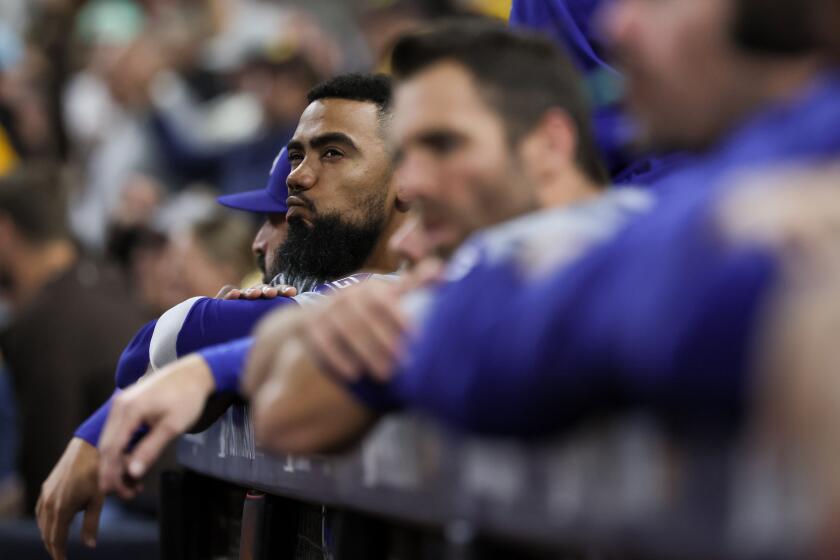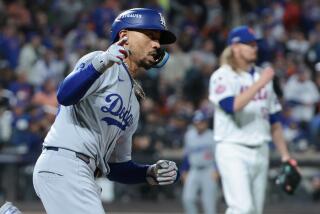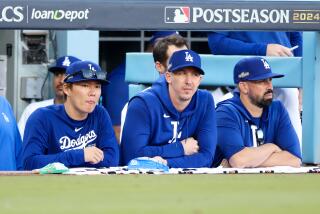
- Share via
SAN DIEGO — The point again feels redundant at this stage, but it’s nonetheless worth repeating because it’s the reason why the Dodgers are on the verge of another divisional-round elimination: Their starting pitching is atrocious.
The suspicions of the winter, which became legitimate fears in the regular season, have turned into a full-scale disaster in these playoffs.
Incredibly, the problem everyone saw coming is somehow even worse than imagined. In this National League Division Series, their starters have registered a combined earned-run average of 10.13. The Dodgers are behind in the best-of-five series to the San Diego Padres, two games to one.
The Dodgers’ starter in their elimination game on Wednesday?
TBD.
As in, to be determined.
The Dodgers’ lack of fury and energy in their loss to the San Diego Padres in Game 3 of the NLDS has the team back on the brink of another broken October.
“I see one of our relievers starting,” manager Dave Roberts said, because the Dodgers don’t have any traditional starters who are healthy or competent enough to pitch at this stage. Roberts will depend on a parade of relievers to complete nine innings and extend his team’s season.
If the Dodgers force a Game 5, they will start either Yoshinobu Yamamoto, who was charged with five runs in three innings in Game 1, or Jack Flaherty, who was charged with four runs in 5⅓ innings in Game 2.
“This situation isn’t ideal,” Roberts said.
Then again, the situation could be worse. Game 3 starter Walker Buehler, the pitcher of record in the 6-5 defeat at Petco Park on Tuesday, recovered from a six-run second inning, to complete five innings. Because the Padres were the home team and didn’t hit in the bottom of the ninth, the Dodgers bullpen had to cover only three innings.

“Walker did a nice job of keeping his composure and still giving us some length and throwing some zeros after that [six-run inning],” Roberts said.
Starting pitching this ineffective has to be graded on a curve, and Roberts not calling on Blake Treinen, Evan Phillips, Ryan Brasier and Alex Vesia to pitch in Game 3 kept Buehler’s start from being categorized as a complete failure.
Buehler’s second inning cost the Dodgers the game, and this doesn’t count Freddie Freeman’s throw to second base that ricocheted off Manny Machado’s helmet or the mistake Miguel Rojas made of trying to beat a runner to second base instead of flipping the ball to Gavin Lux. Up to that point, Buehler could be called a victim of misfortune. However, he soon contributed to his own demise.

Buehler backed David Peralta into a 1-2 count, only to serve him a 95.5-mph fastball on the inside of the plate that Peralta shot down the right-field line for a two-run double.
He also backed the next hitter, Jake Cronenworth, into a 1-2 count, only to serve him a high 97-mph fastball. Cronenworth slapped the ball to Rojas’ backhand side and reached base on an infield single.
Later in the inning, Buehler had Fernando Tatis Jr. behind in the count at 0-2. Buehler threw a 94.1-mph fastball on the inside part of the plate, which Tatis launched for a two-run home run that extended the Padres’ advantage to 6-1. The game was out of reach, and not even a grand slam by Teoscar Hernández could completely erase the deficit.
“You can’t give up six runs in the playoffs and expect to win,” Buehler said.
There was a time when Buehler could put away hitters with his fastball. Returning this season from his second Tommy John surgery, Buehler lost that ability, which prompted the Dodgers to emphasize the importance of him reinventing himself. Yet, here he was, in his most important start of the season, attempting to overpower his opponents as he did earlier in his career.

“I’m not a 10-, 11-, 12-punchouts-per-nine [innings] guy like I used to be,” Buehler acknowledged. “I think going forward in my career, there’s certainly some things that make me feel like I can do that. But at this point of the year, I’m trying to get people to put the ball on the ground. And I feel pretty good about a lot of the things that I did. Obviously, the ones you’re talking about, not a ton of them were hit 110 [mph], right? So, you know, they found spots and created momentum. I’ve talked ad nauseam about momentum in the playoffs, and I just couldn’t make the one pitch to kind of stop it.”
Only a small handful of starting pitchers have ever regained their previous levels of effectiveness after undergoing a second Tommy John operation. So how could the Dodgers be counting on a pitcher who is facing such a formidable obstacle?
Well, it’s because they thought that if Buehler didn’t return to his old form, some of their other long-shot wagers would hit. They hoped Tyler Glasnow would stay healthy for the entire season even though he never has. They hoped the undersized Yamamoto would be dominant at a level at which he’d never previously pitched. They hoped Bobby Miller would develop into an elite starter.
Their miscalculation could cost them the season.
The Dodgers were unable to wrestle back control of the NLDS from the San Diego Padres, who capitalized on a big second inning to take a 6-5 win in Game 3.
More to Read
Are you a true-blue fan?
Get our Dodgers Dugout newsletter for insights, news and much more.
You may occasionally receive promotional content from the Los Angeles Times.









